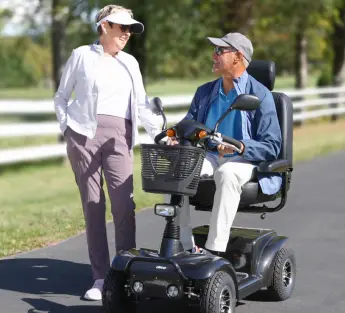Wheelchair Seat Depth
Too short - not enough support. Too deep - potential posture problems. Get the depth right.
It is important to get the depth of the seat right when you specify the dimensions of your wheelchair. The seat should be deep enough so that the seat is in contact with as much of the bottom of your thighs as possible, but not so deep as to hit the back of your calves.
When the seat is too shallow, your upper legs extend beyond the front edge and more pressure is placed on your ischial "sitting" bones. This additional pressure increases the risk of skin breakdown. The chair can’t "carry" you if it can’t make full contact with your body. Without full seat support, your back may hurt since your spine is not in a neutral position.
A too shallow seat also means that your feet will not rest properly in the footrests. Picture a wheelchair with footrests designed to allow the lower legs to be 90 degrees to the ground. If the knees extend out beyond the front of the seat, the legs will have to bend back at the knees so that the feet can rest on the footplates. In order for the feet to be level, they would have to bend unnaturally.
On the other hand, when the seat is too deep, you will be unable to sit properly against the chair back. You will be kept from sliding back fully in the seat, stopped behind the knees. When the seat is too deep, the only way to make contact with the back of the chair is to round the spine. In other words, you will have to slump. Slumping is potentially dangerous for the spine and uncomfortable. This posture also makes it difficult for you to wheel efficiently in a manual wheelchair.
A deeper seat means you’ve chosen a longer frame, and so this means a heavier wheelchair due to the added metal in the frame. When more of the chair is ahead of the axle, you will feel as though you are pushing even more weight. If you require extra depth in the seat pan, you will need to adjust the forward position of the main wheel axles so that the wheelchair is not too front heavy, particularly if you rely on doing wheelies in your wheeling style.
I am very tall, and recently purchased a wheelchair that is two inches deeper than my past wheels so I could have more contact with my legs along the seat. It has worked very well, and it was not a problem to adjust the wheelchair for wheelies and for ease of wheeling, although it did feel slightly heavier at first. Now I can’t tell the difference, partly because I have nothing to compare to anymore, and I probably gained a little strength to compensate for the additional weight just by using the chair.
Don't forget to take into consideration the type of seat back you will use. A fabric upholstered back lets you to sit a little farther back in the wheelchair, and tends to loosen with time unless it is equipped with adjustable tension straps. A rigid back will not change much over time, but some are quite deep and push you forward as you sit, so you may need to add an inch or two to the seat depth to get the proper support.





 Contact Us
Contact Us
 M-F 9am - 6pm ET
M-F 9am - 6pm ET
 Request parts
Request parts Request Service
Request Service
